Choosing the Perfect Drip Irrigation Kit: Guide
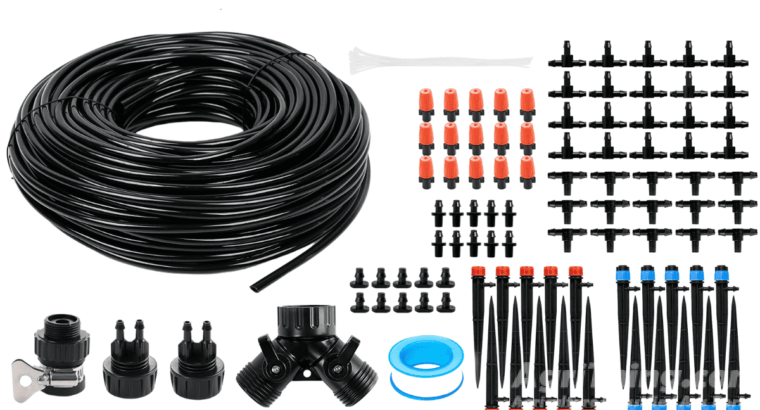
Drip irrigation has become popular among farmers and people who have gardens at home because it saves water and ensures that plants grow well. Choosing a suitable drip irrigation kit is important if you’re considering using a drip irrigation system in your garden. Many options are available, so it can be a bit confusing. But don’t worry. This article will help you pick the right drop irrigation kit for your needs. That way, your garden will thrive, and you’ll be able to save water too.
Table of Contents
Introduction
Drip irrigation waters plants directly at the roots through tubes and emitters. This system provides a slow and steady water supply, minimizing evaporation and runoff and promoting healthier plant growth. A drip irrigation kit simplifies installation by bundling all necessary components into a convenient package.
What is a drip irrigation kit?
A drip irrigation kit usually has everything you need to set up a drip irrigation system. It includes tubes, small devices called emitters or drippers that release water, connectors to join everything together, regulators and filters to control the water pressure and keep it clean, and timers or controllers to schedule when the water flows. Having all these components in a kit saves you time and effort because you don’t have to find and collect each item separately.
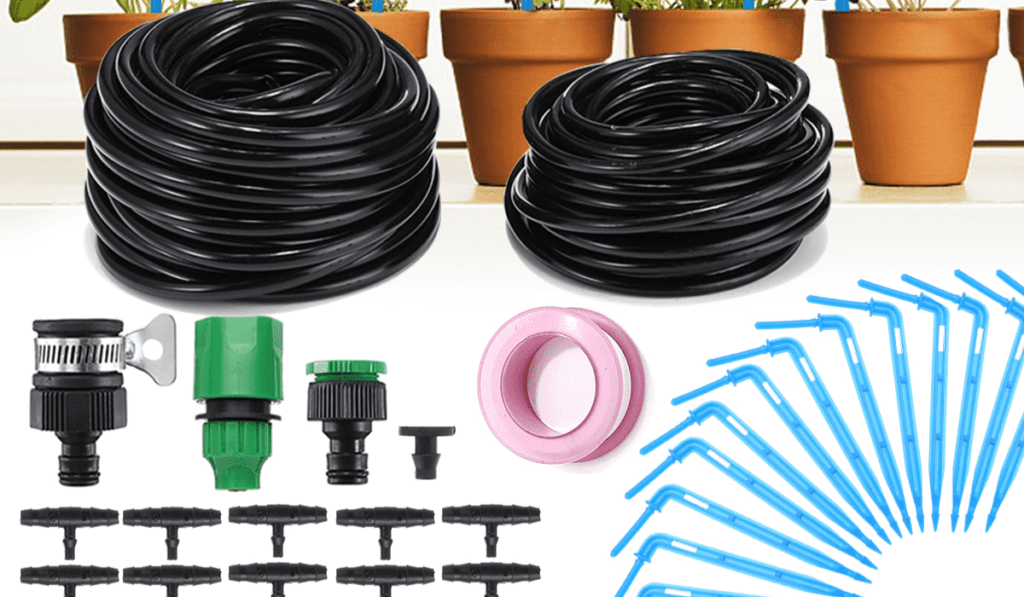
Benefits of using a drip irrigation kit
A drip irrigation kit offers several benefits for farming and garden water management.
- Firstly, it ensures that plants receive water exactly where they need it, reducing water waste and improving water uptake efficiency.
- Additionally, drip irrigation kits help to control weed growth by delivering water directly to the plant roots, minimizing moisture on the soil surface. This targeted watering approach also reduces the risk of plant diseases caused by wet foliage.
- Lastly, drip irrigation kits are relatively easy to install and maintain, making them a practical choice for beginners and experienced gardeners.
Factors to consider when choosing a right drip irrigation kit
To select the most suitable drip irrigation kit for your garden, several factors should be taken into account:
Garden size and layout:
onsider the size and layout of your garden or landscape. Determine the number of plants and their arrangement to estimate the length of tubing and the number of emitters required.
Water source and pressure:
Evaluate the available water source and pressure in your area. Some drip irrigation kits require a minimum pressure level to function optimally. If your water pressure is low, you may need a kit with water pressure regulators to ensure consistent water flow.
Plant types and watering needs:
Different plants have varying watering requirements, such as water consumption rates and preferred moisture levels. Look for kits that offer adjustable emitters or drippers, allowing you to customize the water flow for different plant types.
Budget:
Consider your budget when selecting a drip irrigation kit. Kits vary in price depending on their features and components.
Ease of installation and maintenance:
Look for a drip irrigation kit that is easy to install and maintain. Clear instructions and user-friendly components can make the installation process smoother, especially for beginners.
Components of a drip irrigation kit
| Mainline tubing | The backbone of the drip irrigation system carries water from the source to the emitters. It should be durable, flexible, and resistant to UV rays and chemicals. |
| Emitters or drippers | Release water at a controlled rate near the plant roots. They come in different types, such as inline drippers, micro-sprayers, or micro-sprinklers. |
| Connectors and fittings | Join different tubing sections, ensuring a secure and leak-free connection. Common types include tees, elbows, couplings, and connectors with shut-off valves. |
| Pressure regulators | Maintain consistent water pressure within the drip irrigation system. They are beneficial when the water source pressure exceeds the recommended level. |
| Timers and controllers | Automate the irrigation process by regulating the timing and duration of watering cycles. They offer comfort and allow you to set specific schedules, ensuring your plants receive water even when you’re away. |
Types of drip irrigation kits
Drip irrigation kits come in various types to cater to different gardening needs. Understanding the available options will help you choose the most suitable kit for your requirements:
Basic drip irrigation kits:
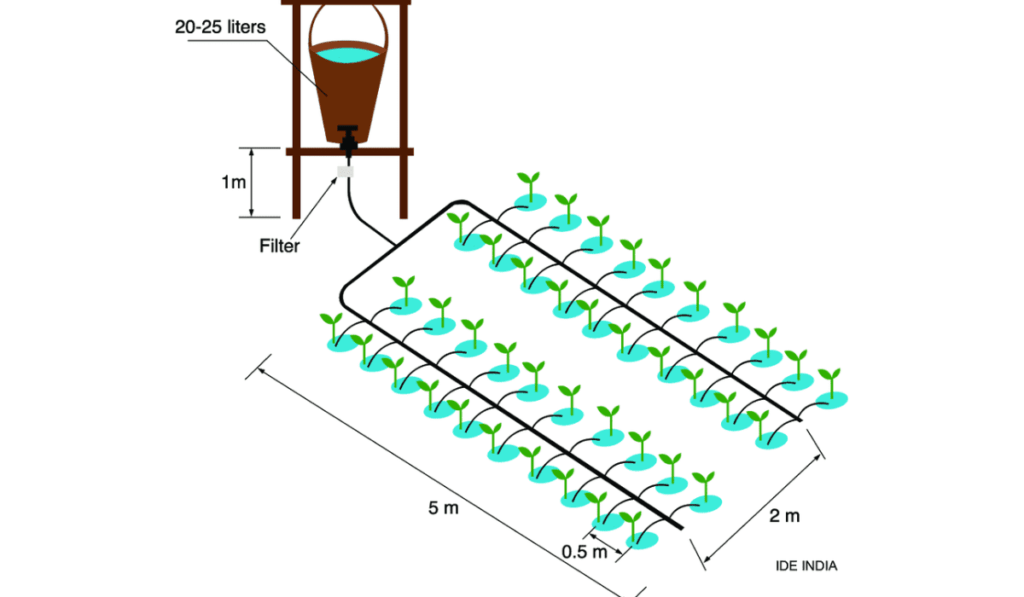
These kits provide the essential components for a basic system. They are ideal for small gardens or beginners who want a straightforward solution without too many customization options.
Customizable drip irrigation kits:
These kits offer flexibility in design and components. You can tailor the system to your garden’s layout and plant watering requirements. They are suitable for more extensive gardens or those with unique arrangements.
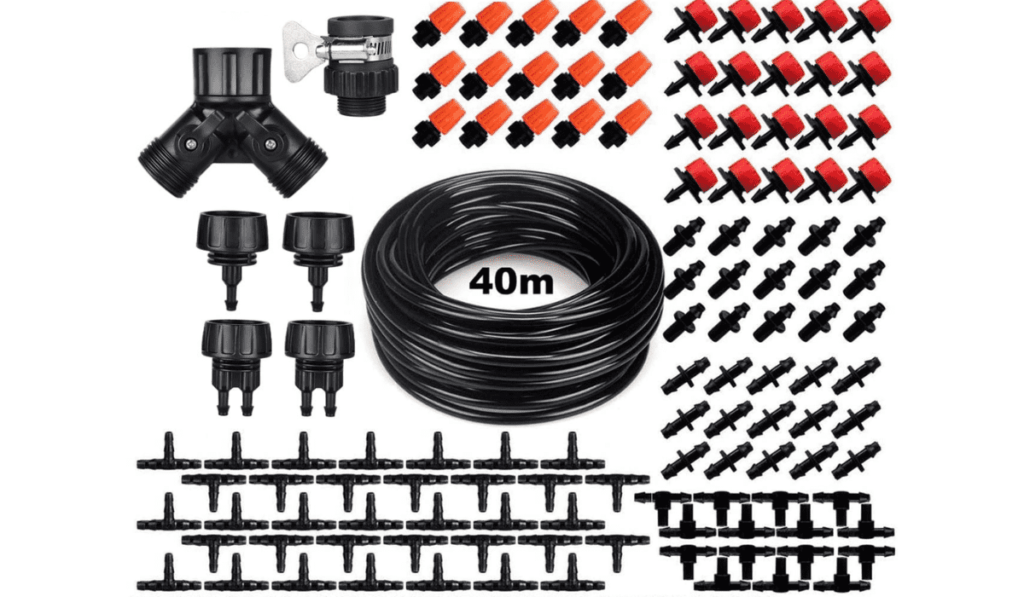
Micro-irrigation kits:
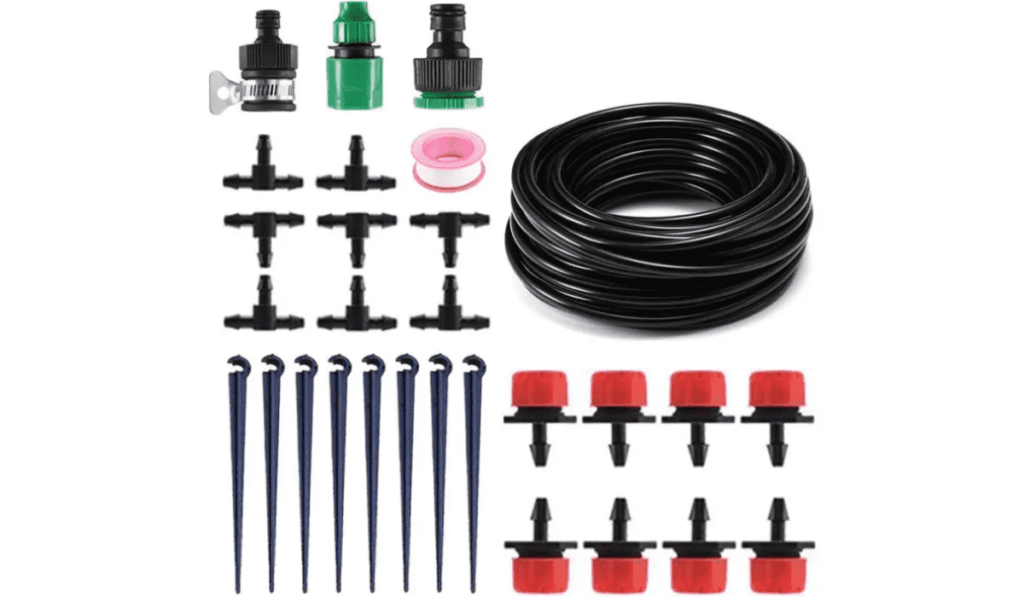
These kits are specifically designed for accurate and efficient watering in containers, hanging baskets, or small garden beds.
Evaluating the quality of a drip irrigation kit
To ensure the longevity and performance of your drip irrigation system, consider the following factors when assessing the quality of a kit:
Material durability:
Choose a kit with high-quality materials that are resistant to UV rays, chemicals, and physical damage.
Water flow rate and coverage:
Check the specifications of the emitters or drippers included in the kit. Ensure they provide a sufficient water flow rate for your plants’ needs and effectively cover the desired area.
Ease of adjustment and control:
Some kits offer adjustable emitters or drippers, allowing you to customize the water flow for individual plants.
Compatibility with other irrigation systems:
if you have an existing irrigation system or plan to expand in the future, ensure that the drip irrigation kit is compatible with other systems.
Additional features to consider
Certain additional features can enhance the functionality and convenience of your drip irrigation system:
Rain sensors:
Rain sensors detect rainfall and automatically suspend irrigation to avoid overwatering. They conserve water by ensuring the system operates only when necessary.
Automatic shut-off valves:
Automatic shut-off valves stop water flow when a leak or breakage is detected in the system. These valves prevent water wastage and potential damage to the garden.
Wireless connectivity and innovative features:
Some advanced drip irrigation kits offer wireless connectivity and intelligent features. These include smartphone apps, Wi-Fi compatibility, and integration with weather forecasts.
How to design Drip Irrigation system:
Sure! Here’s a short paragraph on “How to design a drip irrigation system?” presented in bullet form:
- Plan the layout considering plant spacing, water pressure, and flow rate.
- Choose suitable drip emitters for precise water delivery to the root zone.
- Install a filtration system to prevent clogging of emitters.
- Incorporate a pressure regulator and backflow preventer for optimal performance and safety.
- Lay out the main supply line and branch off with lateral lines.
- Position emitters near each plant for efficient water distribution.
- Test the system for leaks and make necessary adjustments.
- Regularly maintain the system by flushing lines, cleaning filters, and checking emitters.
- Achieve precise watering, minimize waste, and promote healthy plant growth.
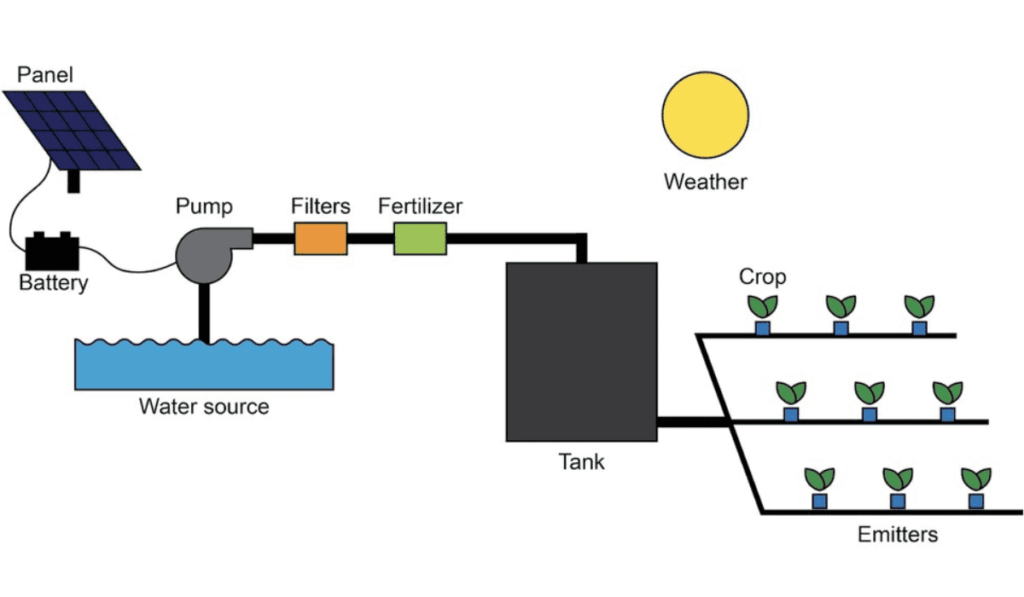

Budget-Friendly Drip Irrigation Kits:
Discover affordable drip irrigation kits at Agrithing.com. These kits provide efficient watering solutions without costing a fortune. These kits are designed to fit different budgets, allowing you to find an option that suits your needs without breaking the bank.
With budget-friendly drip irrigation kits, you can water your garden efficiently while saving water and reducing expenses. These kits offer adjustable flow rates, various emitter types, and components that promote water efficiency.
You can achieve effective irrigation by choosing a budget-friendly drip irrigation kit without spending too much money.
How To Calculate Gallons Per Minute (GPM):
To calculate how many gallons of water flow out per minute (GPM), you will need a 5-gallon bucket and a stopwatch.
Follow these steps:
- Place the 5-gallon bucket under the water source.
- Turn on the water and start the stopwatch at the same time.
- Let the water run for 15 seconds.
- Turn off the water and measure the amount of water in the bucket.
- Multiply the number of gallons by 4 (15 x 4 = 60 seconds = one minute). This will give you the GPM of your water source.
GPH (Gallons Per Hour) is simply GPM multiplied by 60. GPH is commonly used for drip irrigation systems that release water slowly over time. The irrigation run times for these systems are measured in hours.
For example, if you have drip tubing with 1 GPH emitters spaced at 12 inches and the tubing is 100 feet long, it will require 1.67 GPM. This calculation is done by multiplying 1 GPH by 100 (the number of emitters when spaced at 12 inches in a 100-foot run), which equals 100 GPH. Then, divide 100 GPH by 60 (minutes per hour), resulting in 1.67 Gallons Per Minute.
This example shows how simple the design can be for a drip system using tubing or tape. But what about individual emitters? Sometimes we want to water specific plants in our landscape or containers, hanging baskets, or other irregularly shaped plantings. This is where individual emitters come in handy.
Steps to choose the right drip irrigation kit
Follow these steps to select the right drip irrigation kit for your garden:
Assess your garden’s needs:
- Evaluate the garden size, layout, and watering requirements.
- Consider plant types, sun exposure, and soil conditions.
Research available options:
- Explore different drip irrigation kits in the market.
- Read product descriptions, reviews, and specifications.
Read customer reviews and ratings:
- Check feedback on drip irrigation kit performance and reliability.
- Consider both positive and negative reviews.
Compare prices and warranties:
- Compare prices of drip irrigation kits.
- Consider features, quality, and warranty coverage.
Consult with experts or professionals:
- Seek advice from gardening experts or professionals.
- Get personalized recommendations for your garden.
Get your 8/12 PVC Branch Pipe Micro Spray for Drip Irrigation, Garden Irrigation, and more at Agricomplex. Don’t wait, shop now!
Drip Irrigation Kit
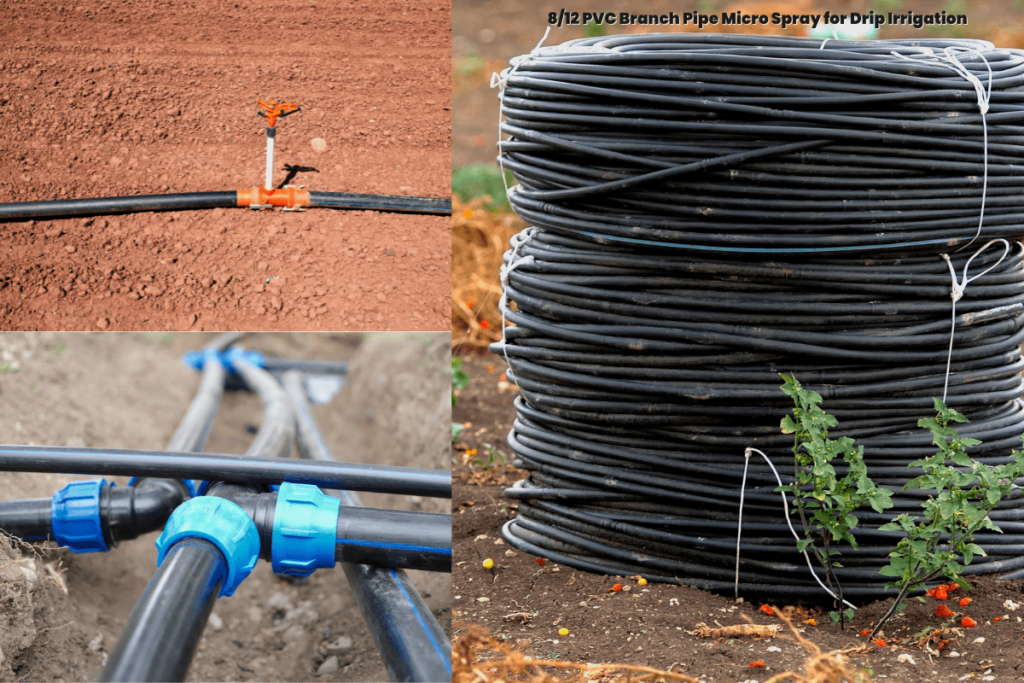
Glossary OF Irrigation Terms
| Term | Definition |
|---|---|
| PPM | Parts Per Million |
| EC | Electrical Conductivity |
| GPG | Grains Per Gallon |
| GPH | Gallons Per Hour |
| GPM | Gallons Per Minute |
| PSI | Pounds per square inch of pressure |
| Drip Tubing | Tubing with drip emitters embedded at a specified spacing along its length |
| Drip Tape | Flexible, collapsible tubing that lays flat when not in use with drip emitters embedded at a specified spacing |
| Supply Line | The hose, pipe, or tube bringing water into the system |
| Emitters | (drippers) Used to control the flow of water, embedded in tape tubing or individual ¼” barbs for use on ¼” tube |
| Filter | A screen, sieves, or discs used to trap small particles in supply water |
| Fertigation | A method of nutrient application where fertilizers are injected through an irrigation system |
| Backflow Preventer | A check valve to ensure no water is allowed to flow back into the supply water |
Conclusion
Picking the right drip irrigation kit ensures water is distributed effectively and efficiently in your garden. You can make a good choice by thinking about how big your garden is, where your water comes from, what types of plants you have, and how much you want to spend. Look at the quality of the parts and any extra features the kit offers to ensure you get a system that will last and be easy to use. Remember to follow the assessment, research, and consultation steps to find the best kit for your garden’s needs.
Frequently Asked Questions (FAQ’s)
How do I determine the water pressure in my area?
To determine the water pressure in your area, you can use a pressure gauge that attaches to an outdoor tap. Simply connect the gauge to the faucet and turn on the water. The gauge will display the pressure level, allowing you to assess if it meets the requirements of your chosen drip irrigation kit.
Can I install a drip irrigation kit myself?
Drip irrigation kits are designed for easy installation and can often be installed by homeowners.
Are drip irrigation kits suitable for all types of plants?
Drip irrigation kits are suitable for a wide range of plants, including vegetables, flowers, shrubs, and trees. However, some plants may have specific watering requirements or may not be suitable for drip irrigation.
Can I expand my drip irrigation system in the future?
Yes, many drip irrigation kits are expandable, allowing you to add more tubing, emitters, or zones as your garden grows. Consider choosing a kit that offers scalability and compatibility with additional components or systems.
How often should I maintain my drip irrigation system?
Regular maintenance is essential to ensure the optimal performance of your drip irrigation system. Inspect the emitters, tubing, and filters periodically for clogs or damage. Clean or replace clogged emitters and filters as needed. Additionally, check for leaks or breaks in the tubing and repair them promptly. Proper maintenance will help prolong the lifespan of your system and ensure efficient water distribution.
Related Articles
People Also Asked
How do I select the right drip irrigation kit for my garden?
Consider garden size, plant water requirements, soil type, and budget. Look for adjustable flow rates compatible with your water source and durable materials.
Can I customize a drip irrigation system?
Yes, drip irrigation systems are highly customizable. You can adjust the spacing and emitter types and add timers, filters, and pressure regulators.
Are drip irrigation kits suitable for all types of plants?
Drip irrigation kits are generally suitable for various plants, but research specific watering needs. Some plants with specialized requirements may need improvement.
How often should I water my plants with a drip irrigation system?
Watering frequency depends on plant species, soil type, weather, and plant needs.
Do drip irrigation kits save water?
Drip irrigation kits are water-efficient, delivering water directly to roots and minimizing evaporation and runoff. They save water compared to traditional methods.



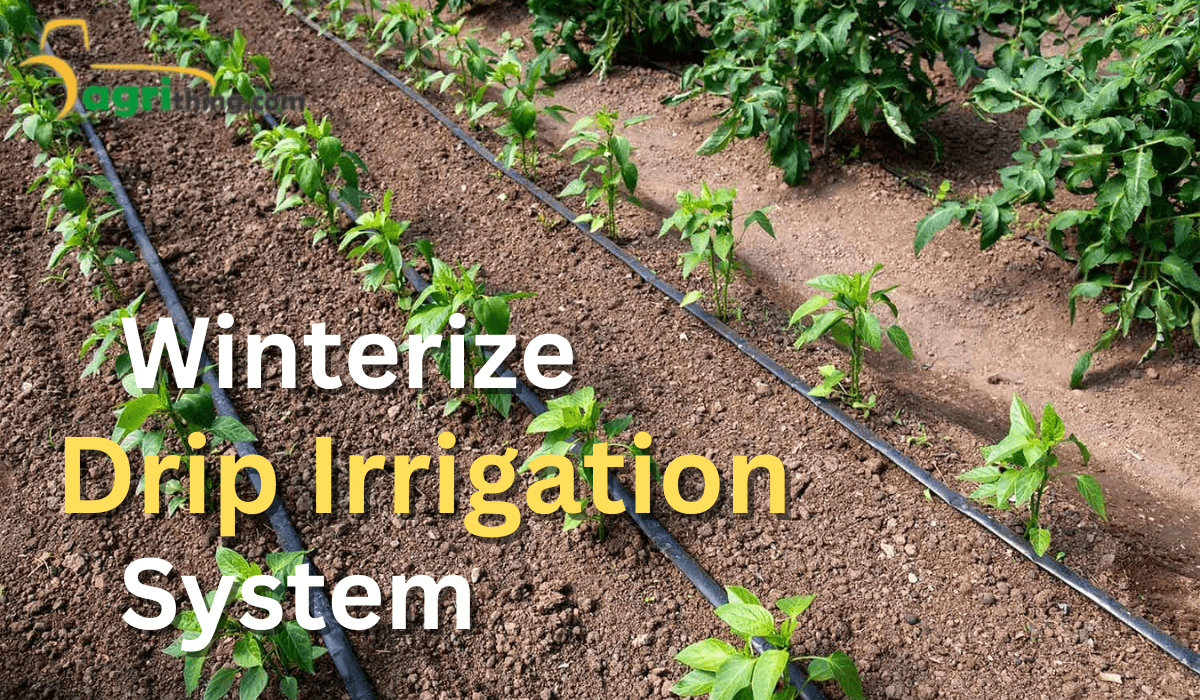
Leave your comment